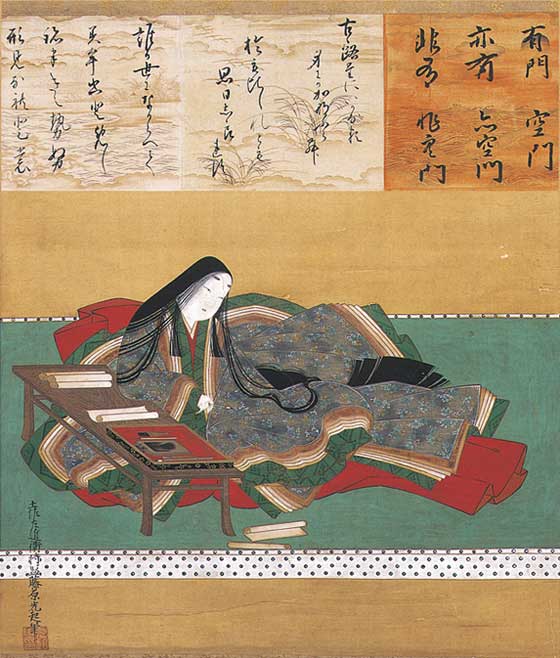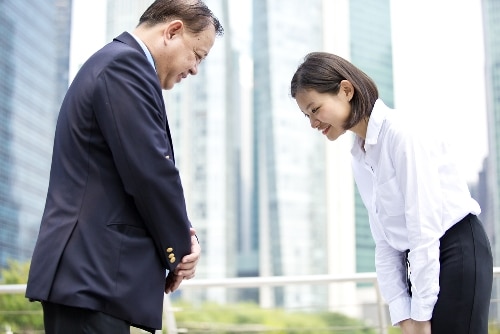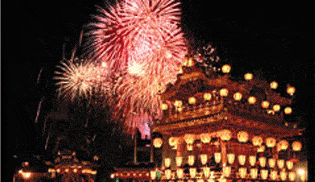Japan Culture
Literature
Books, manga, magazines, and newspapers are also a part of the Japanese culture. Even though TV and other forms of entertainment have led to a decline in the time spent reading, bookstores are everywhere and public libraries offer a huge selection of books. Local municipalities offer reading sessions of writings such as ‘Genji monogatari’ (The Tale of Genji) as well as poem classes. There are also second-hand shops dedicated exclusively to selling used books, magazines, and music software cheaply. The Kanda district in downtown Tokyo has been famous for selling second-hand books for more than 80 years.

Bowing

Bowing is probably the best-known feature of Japanese etiquette outside Japan. Bowing is considered extremely important in Japan, so much so that, although children normally begin learning how to bow from a very young age, companies commonly provide training to their employees in how to execute bows correctly.
Bowing is a gesture of respect. Different bows are used for apologies and gratitude, to express different emotions, humility, sincerity, remorse, or deference, and in various traditional arts and religious ceremonies.
Basic bows are performed with the back straight and the hands at the sides (boys and men) or clasped in the lap (girls and women), and with the eyes down. Bows originate at the waist. Generally, the longer and deeper the bow, the stronger the emotion.
Bows can be generally divided into three main types: informal, formal, and very formal. Informal bows are made at about a fifteen degree angle and more formal bows at about thirty degrees. Very formal bows are deeper.
The etiquette surrounding bowing, including the length and depth of bow, and the appropriate response, is exceedingly complex. For example, if the other person maintains his or her bow for longer than expected (generally about two or three seconds), it is polite to bow again, upon which one may receive another bow in return. This often leads to a long exchange of progressively lighter bows.
Generally speaking, an inferior bows longer and more deeply, and more frequently, than a superior. A superior addressing an inferior will generally only nod the head slightly (some people may not bow at all), while an inferior will bend forward slightly from the waist.
Bows of apology tend to be deeper and last longer than other types of bow. They tend to occur with frequency during the apology, generally at about 45 degrees with the head lowered and lasting for at least the count of three, sometimes longer. The depth, frequency and duration of the bow increases with the sincerity of the apology and the severity of the offence. Bows of thanks follow the same pattern. In extreme cases a kneeling bow is performed; this bow is sometimes so deep that the forehead touches the floor. This is called saikeirei , literally “most respectful bow.”
When dealing with non-Japanese people, many Japanese will shake hands. Since many non-Japanese are familiar with the custom of bowing, this often leads to a combined bow and handshake which can be quite complicated to execute. Bows may be combined with handshakes or performed before or after shaking hands. Generally when bowing in close proximity, as necessitated when combining bowing and shaking hands, people turn slightly to one side (usually the left) to avoid bumping heads.
Japanese Festivals


Fixed Days
Seijin Shiki : Coming of Age Day (second Monday of January)
Hinamatsuri : Doll Festival (3 March)
Hanami : Flower Viewing (late March to early April)
Tanabata : star festival (7 July)
Shichi-Go-San : festival day for children aged three, five and seven (15 November)
Omisoka : New Year’s Eve (31 December)
Setsubun : division of season ( beginning of each season ( spring, summer, autumn, winter ) )
Ennichi : temple fair (holy days related to Kami and/or Buddha)
Japanese New Year

Tea Ceremony
Tea Ceremony is known as one of Japanese cultural traditions. Although SEN Rikyu, who established the foundation of so called tea ceremony, mentioned that Cha-no-yu, Chado, or tea ceremony was only making and drinking tea, many people have been attracted by the ceremony. In a tea gathering or a tea party, a host and a guest can share a sense of togetherness in a small tea house. A host and a guest are not usually expected to talk physically but spiritually, while in an English-styled tea party, people are expected to talk each other physically.

In the eighth century, the custom of drinking green tea was brought from China to Japan by a monk. As a result, the custom of drinking tea in Japan was popular among mainly monks at that time. In the twelfth century, Eizai, a Japanese monk, presented tea to MINAMOTO Sanetomo, a general, the custom spread to the samurai class. Then, the custom became popular among citizens in the fourteenth century. At that time, MURATA Shuko was spiritually awakened by Zen, and he found the Buddha’s thought in the way of making and drinking tea. That is, any book didn’t have the Buddha’s thought but life including making and drinking tea had. TAKENO Jouo developed Shuko’s idea, and SEN Rikyu finally established the foundation of Chado, or tea ceremony in the sixteenth century.
The Spiritual Aspect
Hanging Scroll (Kakemono)
A Hanging Scroll, or kakemono is one of the most important equipment in a tea room because it symbolizes the spiritual aspect of the ceremony; a host decides which kakemon he chooses in order to symbolize his purpose for a particular ceremony to guests.
- WA-KEI-SEI-JAKU : It is said that this word shows the basic idea of chado. “Wa” means harmony. “Kei” means respect.
“Sei” means purity. “Jaku” means tranquillity. We can finally reach “jaku” through “wa”, “kei” , and “sei.” - ICHI-GO-ICHI-E : Meet once. People can have only one particular tea party (or an event in life) even though the same people
will meet again. So, one moment is very important, and meeting people is so solemn. - EN : Freedom, Equality, and Indiscrimination
- MU : MU is not EN. MU consists of all objects and ideas in the world such as Yes, No, Zero, and One even though they
seems to be opposite. - SHU-JIN-KOU : True oneself
- KITSU-SA-KO : It is saying that a bowl of tea is served to everyone whoever wants.

Actual Steps - Guest
Place your sensu (folding fan) in front of you.
Open the fusuma.
Place your hands on the tatami (tatami mat).
Look into the tearoom.
Move the sensu forward.
Edge, while seated, into the tearoom.
Stand from your right foot.
Walk to the tokonoma (alcove), and sit down.
Place the sensu in front of you.
Make a formal bow.
View the scroll, and then the flowers and the flower container Again, make a formal bow.
Stand form your left foot.
Crossing the kayoi-datami and then the ro-datami, walk to the dogu-tatami. (Walk on specific tatamis.)
Cross the tatami edging with your right (left) foot.
Be careful not to step on the tatami edging.
Sit in front of the kama (kettle).
Respond to the host’s request and make a bow. “I will partake of the sweet.”
Make a bow to the next guest. “Excuse me for going before you.”
Take the the kashiki (container for sweets) with your both hands.
Raise the kashiki slightly to express thanks.
Put the kashiki back down.
Place your kaishi (packet of paper) in front of you.
Place the folded edge towards you.
With your right hand, first take the far dry sweet.
Place it on the kaishi.
Next, take the near dry sweet.
Pass the kashibachi to the next guest.
Partake of them.
Stand form your right foot.
Cross the tatami edging with the right foot.
Sit down, and take the chawan (teabowl).
Stand from your left foot.
Turn, and cross the tatami edging with your left foot.
Return to your seat and sit down.
Place the chawan between you and the main guest inside the tatami edging.
Bow and say, “I will join you.”
Place the chawan between you and the next guest.
Bow and say “Excuse me for going before you.”
Place the chawan in front of you inside the tatami edging.
Bow and say, “Thank you for the tea” to the host.
Take the chawan with your right hand.
Place the chawan on your left palm.
Steady the chawan with your right hand.
Bow your head slightly to express thanks.
Turn the chawan clockwise twice in order to avoid its front.
Drink the tea to the last tip.
Wipe the place where you drank from with your right thumb and index finger.
Wipe your fingers on your kaishi.
Turn the chawan back so that the front faces you.
Place the chawan in front of you outside the tatami edging.
Take a closer view of the chawan.
Pick it up with both your hands.
Rest your elbows on your knees. (not to pick the chawan up high)
Take a closer view of the chawan again.
The host’s assistant comes to take the chawan.
You both bow.
The rule of Making Usucha (thin tea) - Basic Idea
Place the tools (the chawan-teabowl, the chasen-tea whisker, the chashaku-teascoop, the natsume-container of grained tea powder, etc.)
Purify the tools such as the natsume, and the chashaku with the fukusa (silk cloth).
Check the chasen. First, pour the hot water into the chawan. Then, put the chasen into the chawan, and raise the chasen in order to check the tines.
Rinse the chasen.
Wipe the chawan with the chakin (linen cloth).
Scoop the powdered green tea from the natsume.
Put the powdered green tea into the chawan.
Whisk the thin tea.
Turn the chawan clockwise twice with your right hand to show the front to the guests.
Serve the tea.
Clean the chasen above the chawan pouring the hot water, and rinse the chasen in the chawan. Discard the water into the kensui again.
Clean the chashaku with the fukusa.
Place the tools again.
Return to the entrance with the tools.
